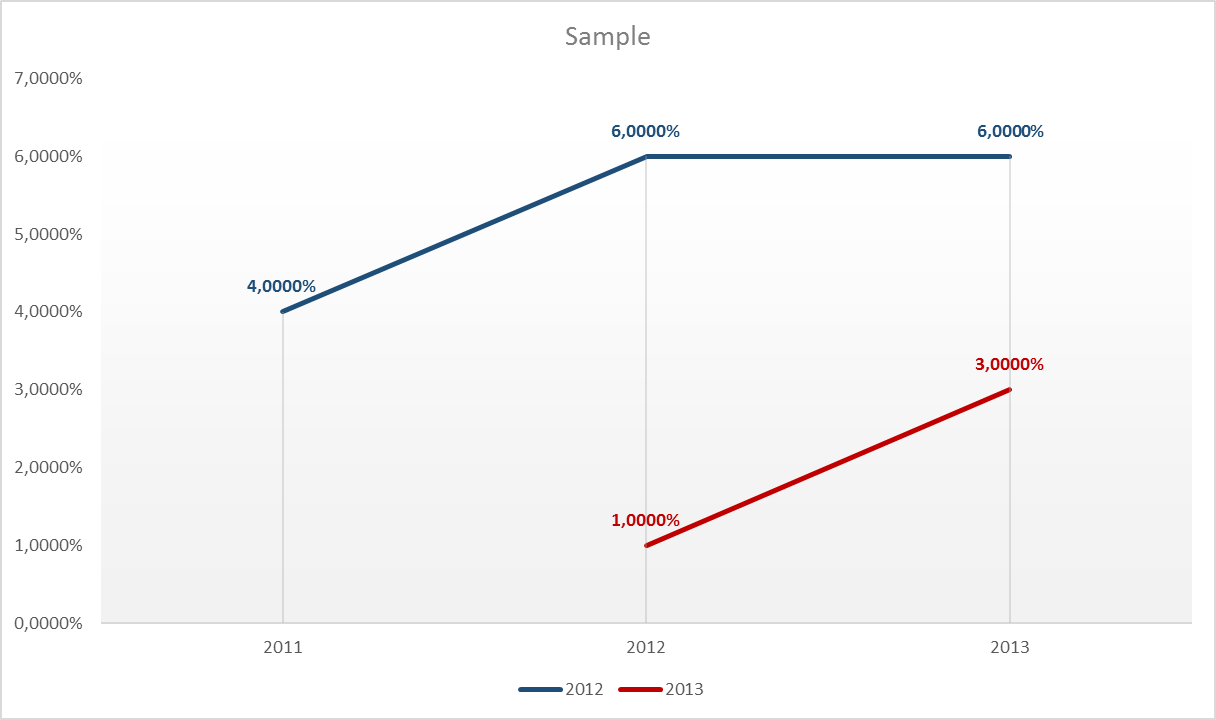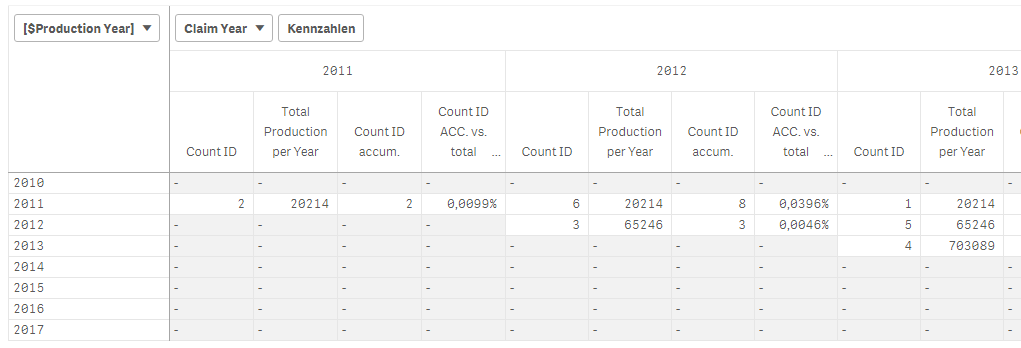- Mark as New
- Bookmark
- Subscribe
- Mute
- Subscribe to RSS Feed
- Permalink
- Report Inappropriate Content
Cumulative Percentage sum of a row obtained by a pivot table in Qlik Sense
Dear all,
I have a big issue and I think that what I have to do goes far beyond my competences.
I have loaded 2 tables in the script, there are other colums but I need only some of them to compute the calculation:
[Purchased]
| Item | Supplier | Quantity | Turnover | Year |
|---|---|---|---|---|
[Database]
| idOrder | Item | Supplier | Machine | Production year | Claim Year |
|---|---|---|---|---|---|
What I need to do is to compute a cumulative sum of the percentage of defects of a single item ( count(idorder)/quantity), for a supplier;
more specifically:
in 2011 I produced and sold a machine;
In 2011 I received 4 claims (4 id.orders) of representing 2 different items [A and B] (for simplicity 2 claims per item); In 2012 i received 2 claims, regarding in this case of the 2 different items considered before;
in 2012 i produced and sold another machine;
in 2012 i received 1 claim, in 2013 a recieved 2 claims.
I have in the table (purchased) the yearly quantity purchased of that specific item, for simplicity Production Year is the same of Purchased Year.
my index should be somthing like this:
| Claim 2011 | claim 2012 | claim 2013 | Purchased | ||||||
|---|---|---|---|---|---|---|---|---|---|
| 2011 | 4/100 = 4% | 2/100=2% | 0% | 100 (total sum of items) | |||||
| 2012 |
|
| 100 (total sum of items) |
in a graph they would be represented like this:
y : cumulative sum
x : year of claim

This is what I have to do. In excel is simple but too much time consuming. I don't get something in order to do this in qlik sense.
Thank you in advance if anyone can help me
- « Previous Replies
-
- 1
- 2
- Next Replies »
Accepted Solutions
- Mark as New
- Bookmark
- Subscribe
- Mute
- Subscribe to RSS Feed
- Permalink
- Report Inappropriate Content
I think I got it ... expression:
aggr(rangesum(above(Count([ID ordine]),0,RowNo()))/sum(total <[$Production Year]> Qty),([$Production Year],(NUMERIC, ASCENDING)),([Claim Year],(NUMERIC, ASCENDING)))
--> it's a combination of Using inter-record functions: swap x-axis and legend in charts and Running totals per dimension (RangeSum(), sortable Aggr()...)

- Mark as New
- Bookmark
- Subscribe
- Mute
- Subscribe to RSS Feed
- Permalink
- Report Inappropriate Content
If your expression is sum(kpi); to do the cumul :
rangesum(above(sum(kpi),0,rowno())
Hope this helps
- Mark as New
- Bookmark
- Subscribe
- Mute
- Subscribe to RSS Feed
- Permalink
- Report Inappropriate Content
Thank you Omar,
the problem is that the kpi is calculated merging two tables.. but the merge doesn't work properly
my expression is Count(idOrder)/Qty (per item and per Year).. so it's something i don't know how to save and where to store it, in a column? I don't know... Actually is something like a matrix division with a column vector, where the matrix is [Production Year]x[Claim Year] * Purchased (where year of purchasing = Production Year)....I'm stucked totally in this
- Mark as New
- Bookmark
- Subscribe
- Mute
- Subscribe to RSS Feed
- Permalink
- Report Inappropriate Content
or perhaps:
rangesum(before(sum(kpi),0,columnno())
in pivot table with horizontal dimensions...
- Mark as New
- Bookmark
- Subscribe
- Mute
- Subscribe to RSS Feed
- Permalink
- Report Inappropriate Content
it doesn't work in the expression, because my KPI is
Count(idOrder)/Qty
in the script I don't know how to write it as are two different tables... actually, what I want to compute is the ratio between of the number of defected item (in year X) on the Quantity of that item in that year, per each year... In 1 table I have the yearly quantity purchased for a specific item, in the other table I have to sum the number of claims.. How can I do it? I think that setting things like this is creating me some complexities. Do you know how to o it ?
- Mark as New
- Bookmark
- Subscribe
- Mute
- Subscribe to RSS Feed
- Permalink
- Report Inappropriate Content
I think we cannot help you as long as you don't prepare a sample...
- Mark as New
- Bookmark
- Subscribe
- Mute
- Subscribe to RSS Feed
- Permalink
- Report Inappropriate Content
Thank you Robin, I don't know exactely if this sample is sufficient for you, in case let me know, i just prepare it like this
My kpi: Count(idOrder)/Qty
in the script I don't know how to write it as are two different tables... actually, what I want to compute is the ratio between of the number of defected item (in year X) on the Quantity of that item in that year, per each year... In 1 table I have the yearly quantity purchased for a specific item, in the other table I have to sum the number of claims.. How can I do it? I think that setting things like this is creating me some complexities. Do you know how to o it ?
- Mark as New
- Bookmark
- Subscribe
- Mute
- Subscribe to RSS Feed
- Permalink
- Report Inappropriate Content
if Production Year is the same as Purchasing Year, then you need a syntethic key or a link table containing
- ITEM
and
- Production/Purchasing Year
for getting the quantity per item per year...
Alternatively you could use P() function, but I think the link table solution is easier to understand for beginners...
So please upload your 2 Input files so that I can rebuild the data model...
Regards
- Mark as New
- Bookmark
- Subscribe
- Mute
- Subscribe to RSS Feed
- Permalink
- Report Inappropriate Content
Thank you Robin,
these are the sample files in excel I used.
I understand the chance of linking the table creating a synthetic key, but what if I want, once the model is built, to filter by Item? I won't be able to aggregate all the defects together, but I will have item-year, right?
Thank you for your help,
regards
Damiano
- Mark as New
- Bookmark
- Subscribe
- Mute
- Subscribe to RSS Feed
- Permalink
- Report Inappropriate Content
ok this is a very fast try of mine, please have a look if the data is ok, then we could talk about the line chart...

- « Previous Replies
-
- 1
- 2
- Next Replies »